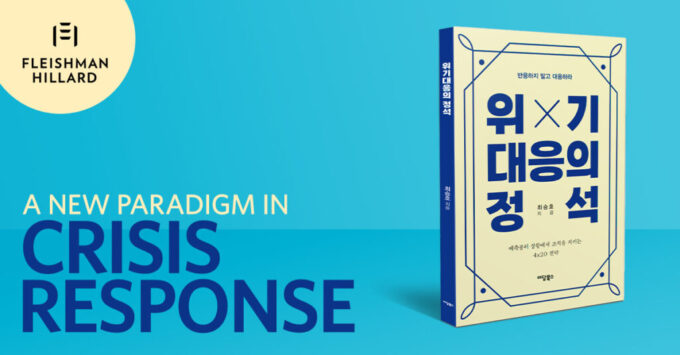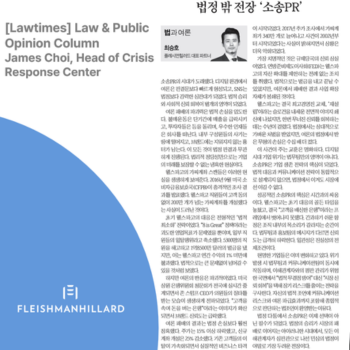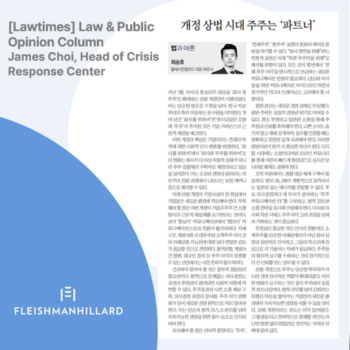The 4 x 20 Strategy: A New Paradigm in Crisis Response
September 5, 2024
By James Choi
In today’s fast-paced business environment, crises are no longer exceptional events but a constant reality that organizations must prepare to face. As a strategic communication expert with over 25 years of experience, I developed a comprehensive framework for crisis response alongside my colleagues at FleishmanHillard Korea: the 4 x 20 Strategy. This approach categorizes crises into four main types and offers 20 specific response strategies for each type.
Understanding the Four Types of Crises
Legal Responsibility: These situations likely involve the organization bearing legal responsibility for the incident in question, such as accidents caused by employee negligence, product defects or secondary incidents occurring while addressing the initial problem.
Moral Responsibility: Here, although there may not be legal responsibilities, there is a moral obligation to respond, influenced by cultural values or local business customs. This is particularly important in many Asian cultures, where the social responsibility of a business is highly valued.
Internal Mistakes: These crises stem from internal errors that do not necessarily lead to legal or moral responsibilities but can result in financial losses and damage to the organization’s reputation. Examples include failed investments, production delays due to mismanagement or loss of competitiveness due to outdated technology.
External Threat Crises: These situations arise where the organization bears no legal or moral responsibility and there are no significant internal mistakes. Examples include malicious rumors, fake news or unjustified regulatory actions that threaten the organization’s normal economic activities.
Key Principles of the 4 x 20 Strategy
Rapid Identification: The strategy provides a framework for quickly identifying the type of crisis, enabling quicker responses.
Stakeholder Perspective: Effective communication and engagement with relevant stakeholders are crucial, along with understanding multi-stakeholder dynamics.
Tailored Response: With 20 specific strategies for each crisis type, organizations can select the most appropriate response based on the specific situation.
Flexibility: The 4 x 20 Strategy is not a rigid set of rules but a flexible framework that can be adapted to various industries and organizational structures.
Proactive Preparation: While we cannot predict every crisis, we can always prepare in advance for various crisis scenarios. The 4 x 20 Strategy emphasizes the importance of having response plans ready for each crisis type.
Precision Communication: Data-driven precision communication can guide organizations more effectively, with the right timing and tone.
Continuous Learning: Each crisis provides an opportunity to refine and enhance the strategy. The 4 x 20 approach encourages post-crisis analysis and strategy updates, as needed.
Implementing the 4 x20 Strategy
Implementing the 4 x 20 Strategy requires a shift in how organizations view crisis management. Here are some key steps to take:
Crisis as a Constant: Recognize that crises are not isolated events but rather a regular aspect of business operations.
Cultural Shift: Cultivate a culture where every employee understands their role in crisis prevention and response.
Training and Simulation: Conduct regular crisis simulations based on the four crisis types to familiarize teams with the 20 response strategies.
Integration with Daily Operations: Incorporate crisis management principles into daily business activities rather than treating it as a separate function.
Leadership Commitment: Ensure that top leadership is committed to, and involved in, crisis preparedness and response.
The Future of Crisis Management: Integrating Enterprise Risk Management and the 4 x 20 Strategy
In today’s complex and interconnected business environment, the importance of effective crisis management is increasingly recognized. While Enterprise Risk Management (ERM) focuses on identifying and mitigating potential risks, the 4 x 20 strategy provides action plans for crises that have actually occurred.
By combining ERM’s preventive approach with the 4 x 20 strategy’s responsive approach, organizations can more effectively deal with crises across the board. This integrated approach allows organizations to prevent crises, respond quickly to those that do occur, and ultimately transform crises into opportunities.
For organizations facing new and evolving challenges in today’s fast-changing business environment, the combination of ERM and the 4 x 20 strategy can be an essential tool in building a resilient and future-oriented crisis management framework.

James Choi is a svp and partner at FleishmanHillard in Korea and wrote “The Principles of Crisis Response,” published in Korean on August 30, 2024.
Find Out More
-
Battleground Outside the Courtroom: 'Litigation PR'
September 10, 2025
-
Four Faces of a Crisis
August 27, 2025
-
Embracing shareholders as partners and growing together
August 20, 2025


